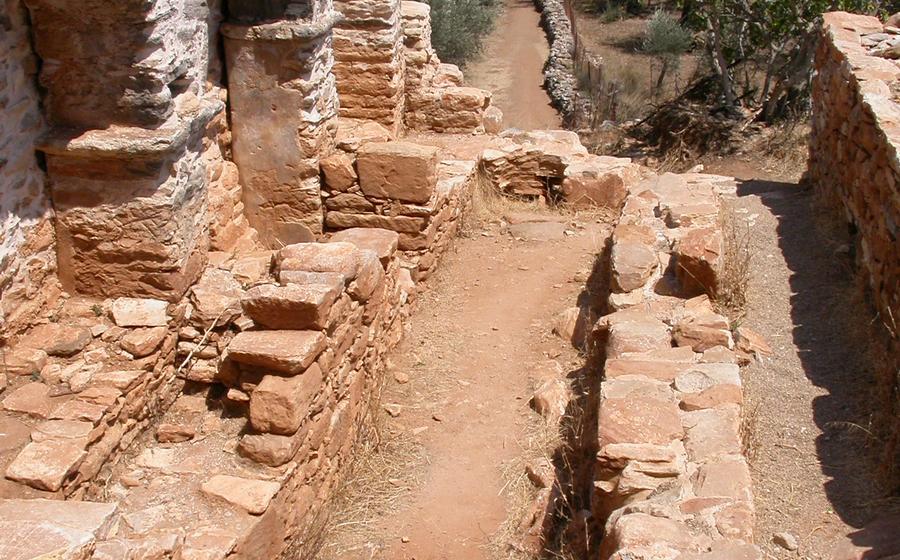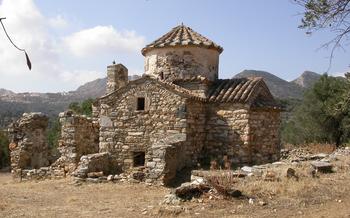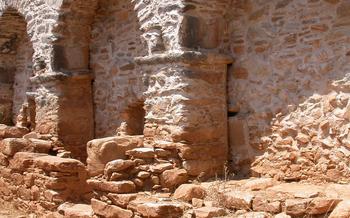
The Mitropolis Site
- Historical Background
- Location and Accessibility:
- Architectural Highlights
- Religious Significance
- Cultural Importance
- Visiting Tips: Making the Most of Your Experience
- Exploring the Surroundings
- Photography and Social Media:
- Historical Anecdotes
- Preservation and Conservation
- Local Cuisine and Restaurants
- Shopping and Souvenirs
- Accessibility for Differently-Abled Visitors
- Sustainable Tourism Practices at the Mitropolis Site
- Insider Tip: Unveiling the Secret Chapel of Agios Georgios
Historical Background
Journey back in time as we explore the ancient history and significance of Naxos, an island steeped in mythology and civilization. The Mitropolis Site stands as a testament to the island's rich religious and cultural heritage. Its roots can be traced back to the 6th century AD, when the first Christian basilica was erected on this very spot. Over the centuries, the site has undergone transformations, influenced by various architectural styles, and served as a spiritual center for the people of Naxos.
In the 16th century, the Venetians, who ruled the island at the time, constructed a new church on the site, incorporating elements of Gothic and Renaissance architecture. This church, dedicated to the Assumption of the Virgin Mary, became the cathedral of Naxos and a symbol of the island's religious devotion.
The Mitropolis Site has witnessed countless religious ceremonies, baptisms, marriages, and festivals throughout the centuries. It has been a place of refuge, celebration, and spiritual renewal for generations of Naxos residents. Today, it stands as a living testament to the island's enduring faith and cultural traditions.
Location and Accessibility:
The Mitropolis Site is strategically located in the heart of Naxos Town, making it easily accessible on foot or by public transportation. To reach the site, visitors can stroll along the charming cobbled streets of the old town, starting from the main square, Plateia Protodikiou. The site is situated just a short walk away, nestled between the Town Hall and the Archaeological Museum.
For those arriving by car, there are several parking options available nearby. Visitors can park at the designated parking lot near the port or find street parking in the surrounding streets. It's important to note that parking spaces can be limited, especially during peak tourist season, so it's advisable to arrive early or consider alternative transportation options.
To enhance your visit, consider combining a trip to the Mitropolis Site with other nearby attractions. Naxos Town offers a wealth of historical and cultural landmarks within walking distance. Explore the Venetian Castle, perched on a hilltop overlooking the town, or immerse yourself in the fascinating exhibits at the Archaeological Museum, showcasing the rich history of Naxos from prehistoric times to the Byzantine era.
Architectural Highlights
The Mitropolis Church, the centerpiece of the Mitropolis Site, stands as a testament to Byzantine architectural prowess. Constructed in the 16th century, the church boasts an impressive cruciform design, characterized by its central dome and four smaller domes at the corners. The exterior is adorned with intricate carvings and sculptures, showcasing the skill and artistry of the builders.
Inside, the church's grandeur unfolds, with its vaulted ceilings, ornate frescoes, and a magnificent iconostasis. The iconostasis, a masterpiece of woodcarving, separates the sanctuary from the nave and features a collection of exquisite icons depicting biblical scenes and saints. The walls and ceiling are adorned with vibrant frescoes, narrating stories from the Bible and depicting religious figures. The church's interior is a symphony of colors, gold leaf, and sacred imagery, creating an awe-inspiring atmosphere.
Surrounding the church are several other buildings that contribute to the site's architectural significance. The bell tower, with its distinct Venetian influence, stands tall, its bells announcing the hours and calling the faithful to prayer. The Bishop's Palace, with its elegant arched windows and stately facade, reflects the ecclesiastical authority associated with the site. These structures, together with the church, form a harmonious ensemble that showcases the architectural heritage of Naxos.
Efforts to preserve and restore the Mitropolis Site have been ongoing, ensuring its continued existence for future generations. Restoration work has focused on repairing structural damage, conserving the frescoes and icons, and maintaining the integrity of the site's architectural features. These efforts have been instrumental in safeguarding the site's historical and cultural significance, allowing visitors to appreciate its beauty and grandeur.
Religious Significance
The Mitropolis Site holds immense religious significance as a center of worship and pilgrimage for the people of Naxos. The site is dedicated to the Assumption of the Virgin Mary, who is the patron saint of the island. The Mitropolis Church serves as the seat of the Greek Orthodox Diocese of Naxos and the Lesser Cyclades, and it hosts regular religious services, festivals, and celebrations throughout the year.
The annual feast day of the Assumption of the Virgin Mary, celebrated on August 15th, is a particularly important event at the Mitropolis Site. During this time, the church is adorned with flowers and decorations, and a grand religious procession takes place through the streets of Naxos Town. Pilgrims from neighboring islands and mainland Greece flock to the site to participate in the festivities and pay homage to the Virgin Mary.
Other religious festivals and celebrations held at the Mitropolis Site include Easter, Christmas, and the Feast of the Epiphany. These events are marked by special services, processions, and traditional customs, attracting both locals and visitors to the site.
The Mitropolis Site is not just a place of worship but also a spiritual center for the community. It offers a serene and sacred space for contemplation, reflection, and connection with the divine. The site's religious significance is deeply ingrained in the cultural fabric of Naxos, and it continues to be a cherished and revered place for the island's inhabitants.
Cultural Importance
The Mitropolis Site is not just a religious center but also a hub for cultural activities and community gatherings. The site hosts various cultural events, exhibitions, and performances throughout the year, showcasing the rich cultural heritage of Naxos. These events range from traditional music concerts and dance performances to art exhibitions and literary readings. The site's atmospheric surroundings provide a unique and inspiring backdrop for these cultural events, creating a memorable experience for visitors.
The Mitropolis Site is also a venue for promoting local arts, crafts, and traditions. Artisans and craftsmen from Naxos and the surrounding region showcase their handmade products at the site, offering visitors a chance to purchase unique souvenirs and support local talent. Visitors can find intricate pottery, woven textiles, jewelry, woodwork, and other traditional crafts that reflect the island's rich cultural heritage. By purchasing these items, visitors not only take home a piece of Naxos but also contribute to the preservation and promotion of local crafts.
The Mitropolis Site serves as a living museum, showcasing Naxos's cultural heritage through its architecture, religious traditions, and cultural events. It is a place where history, religion, and culture intertwine, creating a vibrant and dynamic space that welcomes visitors to immerse themselves in the authentic spirit of Naxos.
Visiting Tips: Making the Most of Your Experience
To fully appreciate the Mitropolis Site, plan your visit during the early morning or late afternoon when the sun's rays cast a warm glow on the buildings and create a picturesque ambiance. Dress comfortably and wear appropriate footwear as you'll be doing a fair amount of walking and exploring. Guided tours are available for a more in-depth understanding of the site's history and significance. Audio guides are also a great option for self-guided exploration. The site offers basic amenities such as restrooms, but it's advisable to carry water and snacks, especially during hot summer days. Remember to be respectful of the religious significance of the site and maintain silence while inside the church. Photography is permitted, but be mindful of other visitors and avoid using flash photography. Join the local community during the annual religious festivals held at the site to experience the vibrant celebrations and traditions firsthand.
Exploring the Surroundings
Beyond the Mitropolis Site itself, visitors can embark on a journey to discover other captivating attractions and landmarks nestled in its vicinity. Just a short stroll away lies the Naxos Archaeological Museum, a treasure trove of ancient artifacts that narrate the island's rich history. Here, visitors can admire a remarkable collection of pottery, sculptures, and inscriptions that provide a glimpse into Naxos's past civilizations.
Another nearby gem is the Venetian Castle, a formidable fortress that once guarded the island from invaders. Perched atop a hill overlooking the town, the castle offers breathtaking panoramic views of Naxos and the surrounding Aegean Sea. Its imposing walls and well-preserved fortifications invite visitors to step back in time and imagine the battles and sieges that took place within its grounds.
For those seeking a spiritual experience, the Church of Panagia Drosiani, located just a few kilometers from the Mitropolis Site, is a must-visit. This early Christian basilica, dating back to the 6th century, is one of the oldest and most significant churches in Greece. Its exquisite Byzantine mosaics, depicting scenes from the Bible, are a testament to the artistic and religious heritage of Naxos.
These are just a few of the many attractions that await visitors in the vicinity of the Mitropolis Site. Whether it's exploring ancient ruins, marveling at medieval architecture, or seeking spiritual enlightenment, there's something for every traveler to discover in the surroundings of this iconic landmark.
Photography and Social Media:
The Mitropolis Site offers a wealth of photographic opportunities for visitors. Capture the stunning architecture of the church, with its intricate carvings and impressive dome. Don't miss the vibrant frescoes and iconography adorning the interior, which tell stories from the Bible and the lives of saints. The surrounding buildings and gardens also provide picturesque backdrops for your shots.
When taking photos, be mindful of the sacred nature of the site. Always ask permission before photographing people, especially during religious ceremonies or services. Respect the privacy of visitors and avoid using flash photography.
To capture the best shots, visit the site during the golden hours of sunrise or sunset, when the warm light casts a magical glow on the buildings. Experiment with different angles and perspectives to create unique and captivating images.
Share your Mitropolis Site experiences with the world on social media! Tag your photos with #MitropolisNaxos and #NaxosGreece to connect with other travelers and share the beauty of this historic site.
Historical Anecdotes
The Mitropolis Site is steeped in history and folklore, adding to its allure. According to local legend, the site was once home to a sacred olive tree that was said to have miraculous powers. People from all over the island would come to the tree to pray for healing, good fortune, and protection. Another tale speaks of a hidden treasure buried beneath the site, waiting to be discovered by a worthy soul.
In the 16th century, the site was the scene of a dramatic event when a group of pirates raided Naxos. The pirates attempted to loot the church and steal its treasures, but they were met with fierce resistance from the local people. After a bloody battle, the pirates were driven away, and the treasures of the church were saved.
The Mitropolis Site has also been associated with several famous historical figures. In the 19th century, the Greek poet Nikos Kazantzakis visited the site and was deeply moved by its beauty and history. He later wrote a poem about the site, which immortalized it in Greek literature.
Preservation and Conservation
The Mitropolis Site, with its rich historical and cultural significance, requires ongoing preservation and conservation efforts to ensure its longevity. Recognizing the importance of protecting this heritage, local authorities and organizations have undertaken various initiatives to safeguard the site. Restoration projects have been implemented to address wear and tear, ensuring the structural integrity of the buildings. Conservation efforts focus on maintaining the original architectural features and artwork, preserving the site's authenticity. However, these endeavors face challenges, including limited funding and the need for specialized expertise. By promoting responsible tourism and encouraging visitors to respect and appreciate the site's heritage, we can contribute to its preservation for future generations.
Local Cuisine and Restaurants
A visit to Naxos is incomplete without savoring the island's delectable cuisine. After exploring the Mitropolis Site, indulge in a culinary adventure at one of the many traditional Greek tavernas or restaurants in the vicinity. Immerse yourself in the vibrant atmosphere as you relish authentic dishes prepared with fresh, local ingredients.
Don't miss the opportunity to try Naxos's signature dish, the mouthwatering potato omelet, a tantalizing combination of eggs, potatoes, and local cheese. For seafood enthusiasts, the grilled octopus is a must-try, offering a taste of the island's abundant marine bounty. Pair your meal with a glass of locally produced wine, renowned for its rich flavor and aroma.
For a truly unforgettable experience, dine at a restaurant with a breathtaking view of the Mitropolis Site. As you savor your meal, let the beauty of this architectural masterpiece enhance your dining experience. Indulge in the flavors of Naxos while immersing yourself in the island's rich history and culture.
Shopping and Souvenirs
A visit to Naxos offers the opportunity to take home a piece of the island's charm through its unique souvenirs. Just a short stroll from the Mitropolis Site, you'll find an array of shops and markets where you can browse for local treasures. From traditional Greek handicrafts to handmade jewelry, there's something for every taste and budget.
Be sure to look out for the distinctive Naxos pottery, known for its vibrant colors and intricate designs. These hand-painted ceramics make for a beautiful and functional souvenir, whether it's a decorative plate or a set of nesting bowls.
For those seeking something truly unique, the Mitropolis Site's surroundings are home to several artisan workshops. Here, you can watch skilled craftsmen at work, creating one-of-a-kind pieces such as woven baskets, leather goods, or intricate silver jewelry. These handcrafted items make for special souvenirs that will remind you of your time in Naxos.
When shopping in Naxos, don't forget to indulge in some culinary delights. The local markets offer an array of fresh produce, herbs, and spices, perfect for creating your own Greek feast. Pick up some Naxos cheese, olives, honey, or traditional sweets to savor the flavors of the island.
Remember to embrace the local culture when shopping in Naxos. Engage with the friendly shop owners, ask about the stories behind their products, and don't be afraid to bargain a bit. The experience of shopping in Naxos is as much about connecting with the locals as it is about finding unique souvenirs.
Accessibility for Differently-Abled Visitors
The Mitropolis Site is committed to providing an inclusive and accessible experience for all visitors. The site features ramps and designated parking spaces for differently-abled individuals, ensuring easy access to the church and surrounding grounds. Furthermore, the site offers accessible tours and services upon request, allowing visitors with disabilities to fully appreciate the site's historical and cultural significance. The Mitropolis Site encourages inclusivity and respect for all visitors, fostering an environment where everyone can explore and enjoy this sacred space.
Sustainable Tourism Practices at the Mitropolis Site
As a responsible traveler, it's essential to embrace sustainable tourism practices when visiting the Mitropolis Site and Naxos as a whole. Here are some ways to minimize your environmental impact and contribute to the preservation of this cultural treasure:
-
Respect the Environment: Avoid littering, and dispose of waste responsibly in designated bins. Refrain from picking flowers or plants, as they are part of the site's natural beauty.
-
Support Local Businesses: Choose locally-owned restaurants, shops, and tour operators to support the local economy. This helps preserve traditional practices and ensures that benefits stay within the community.
-
Opt for Eco-Friendly Tours: Look for tour operators that prioritize sustainability. Consider walking or cycling instead of driving to reduce carbon emissions.
-
Respect Local Culture: Be mindful of local customs and traditions. Dress appropriately, especially when visiting religious sites. Ask permission before taking photos of people, and be respectful of their privacy.
-
Promote Responsible Tourism: Share your experiences with others and encourage them to adopt sustainable practices when traveling. Spread awareness about the importance of preserving cultural heritage and the environment.
By embracing these practices, you can help ensure that the Mitropolis Site and Naxos remain vibrant and welcoming destinations for generations to come.
Insider Tip: Unveiling the Secret Chapel of Agios Georgios
Venture beyond the main path, and you'll be rewarded with the discovery of a hidden gem nestled near the Mitropolis Site—the charming chapel of Agios Georgios. This secluded sanctuary, tucked away amidst tranquil surroundings, offers a serene respite from the bustling streets. Immerse yourself in its intimate atmosphere and admire the intricate frescoes adorning its interior walls, depicting scenes from the life of Saint George. The chapel's rustic charm and peaceful ambiance make it an ideal spot for contemplation and reflection. Embrace the opportunity to connect with the spiritual essence of Naxos and create lasting memories in this sacred space.









